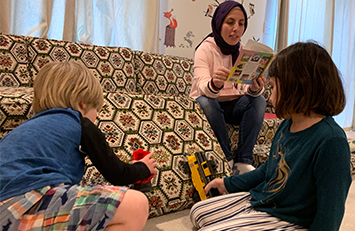
Read a storybook about ramps. Use a ramp to act out the story. How do the characters and objects move down the ramp?
10–25 minutes
Get Ready
Materials you will need:
- Ramp storybook (suggestions: And Everyone Shouted, “Pull!” by Claire Llewellyn, The Little Engine That Could by Watty Piper, Mama Zooms by Jane Cowen-Fletcher)
- Ramp materials, such as a cardboard sheet or box lid, sofa cushion, or baking sheet
- Objects to use as story props, such as toy animals or cars, boxes, pillows, etc.
- Stuffed animal, toy vehicle, doll, or other toy to be the main character (depending on the story)
- Heavy tape, such as masking tape
- Positional Words Chart PDF
Things to do before the activity:
- Become familiar with the story before reading it with your child.
- You can do this activity in two parts if you do not have time to do it all at once.
- Day 1: Read the story. With your child, decide what part you want to act out. (10 minutes)
- Day 2: Act out the story. (15 minutes)
- Set up a ramp: Lean your ramp at an angle against a wall, chair, or sofa and tape that end in place. Tape the other end to the floor to stop it from moving around.
- Look at the words on the Positional Words Chart with your child. Act out some of them: stand in front of your child, have your child sit next to the ramp, and so on.
A character with a speech bubble and crab with a thought bubble.
Let's spot some ramps in the story!
What can we use to build a ramp like that?
Explore!
Step 1.
Look at the storybook cover. Ask your child what she or he thinks the story will be about. Point out any ramps you see on the cover.
- Point out that a ramp is a surface with one end higher than the other.
- What ramps have we seen in our neighborhood?
Step 2.
Read the story aloud. Pause when you come to a page that has a ramp, such as a hill or slide. Notice the steep or gentle incline of the ramp. Think together about how the ramp is used.
- Encourage your child to identify ramps in the story. Are they steep or gentle?
- Talk about how an object tends to move faster down a steep ramp and slower down a gentle ramp.
Step 3.
Choose a favorite event to act out. Review the story. Choose the part of the story you and your child want to act out. Make sure it includes a ramp. Decide which characters you want to pretend to be.
- Point out the ramp in the story section you chose to act out. Is it steep or gentle?
- Notice how fast or slow the object in the story is moving down the ramp.
Step 4.
Set up story props. Notice the location of the ramp in the story. Point out where some objects are located relative to the ramp: for example, next to the ramp, in front of the tree, and so on. Set up your story props in your ramp area.
- Notice the steepness of your ramp. Is our ramp steep or gentle?
- How will our story characters move down the ramp?
Step 5.
Act out the story. Review the story. Reread or help your child retell the story as you act out the events together.
- Use positional words such as between or under as you retell the story.
- Describe how the characters move down the ramp.
Review!
Change the steepness of your ramp. Compare how objects move on your ramp.
- Make the ramp steeper. How do objects move down the steeper ramp?
- Find something in the story that goes over, under, next to, in front of, or behind an object.